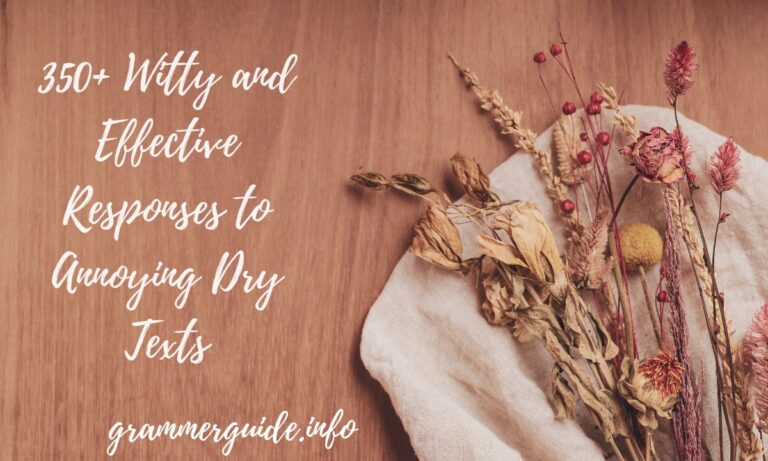Texting has become our primary mode of communication in today’s fast-paced digital world. We rely on messages to stay connected with friends, family, and romantic interests throughout our busy days.
Dry texts can quickly drain the energy from conversations and leave you wondering if the other person is even interested in talking.
Are you tired of receiving one-word answers and struggling to keep conversations alive? This comprehensive collection of clever responses gives you the perfect comeback for every dry text situation.
Understanding Dry Texts
Dry texting happens when someone responds with minimal effort or enthusiasm in their messages. These brief replies often include one-word answers, lack of follow-up questions, or generic responses that don’t advance the conversation.
Many people experience frustration when their thoughtful messages receive only “k” or “yeah” in return.Communication styles vary greatly among different people in the digital world.
Some individuals naturally write elaborate texts while others prefer concise exchanges that get straight to the point. Understanding this spectrum helps reduce misinterpretations and frustrations when engaging with various texting partners.
Signs of Dry Texts
The most common indicators of dry texts include consistently short, one-word replies like “ok,” “fine,” or “sure.” These conversation stoppers provide no hooks for continuing the discussion and place the burden of maintaining dialogue entirely on one person.
When your paragraph receives only an emoji in response, you’re likely dealing with dry texting.Another key sign is the absence of questions or natural conversation flow in messages.
Engaged texters typically ask about your day, opinions, or experiences, creating balanced exchanges. Dry texters rarely initiate new topics and often leave significant time gaps between responses despite being online.
- Excessive use of “lol” or “haha” without additional content
- Never elaborating beyond direct answers to questions
- Ignoring parts of messages that would normally prompt discussion
- Sending identical replies to different conversation topics
Causes of Dry Texts
Many people send dry texts when dealing with time constraints or competing priorities. Someone attending class, working, or handling multiple responsibilities might not have the capacity for engaging conversation. These brief responses often represent an attempt to acknowledge messages without fully disconnecting.
Some individuals struggle with digital communication as a medium. People who excel at in-person conversation might find texting awkward or limiting. Others may have anxiety about how their words might be interpreted without vocal tone or facial expressions to provide context.
- Relationship uncertainty or emotional distance
- Fatigue or mental exhaustion
- Multitasking while responding
- Natural communication style differences
- Disinterest in the current conversation topic
Impact of Dry Texts
Consistent dry texting can create emotional distance between people who otherwise share close connections. When meaningful efforts to communicate receive minimal engagement, it’s natural to question the relationship’s importance to the other person.
Misunderstandings frequently arise when messages lack proper context and clarity. What began as simple brevity can evolve into significant communication breakdowns as both parties develop incorrect assumptions about intentions. Many relationships suffer unnecessarily because of these text-based misinterpretations.
- Decreased motivation to initiate future conversations
- Heightened sensitivity to message timing and content
- Mirroring behavior where both parties eventually send equally dry texts
- Relationship insecurity and overthinking simple messages
Avoiding Dry Texts
Maintaining engaging conversations requires effort from both parties involved in the exchange. Dry texts can kill momentum and make communication feel like a chore rather than a pleasure. Here are effective ways to keep your own messages interesting and engaging.
- Ask open-ended questions that require more than yes or no answers.
- Share personal stories that invite similar sharing from the other person.
- Reference previous conversations to show you were paying attention.
- Include specific details when asking about someone’s day or activities.
- Use descriptive language instead of generic terms when expressing emotions.
- Vary your message length to keep the conversation dynamic.
- Respond to all parts of a multi-part message the other person sends.
- Add voice messages occasionally to change up the communication style.
- Share relevant articles, videos, or memes that can spark discussion.
- Ask for opinions on topics you know interest the other person.
- Offer genuine compliments that can lead to deeper conversation.
- Start conversations with interesting observations rather than just hi.
- Follow up on events or activities the person mentioned previously.
- Use proper grammar and complete sentences to show effort.
- Balance serious topics with lighter conversation to maintain interest.
Best Ways Responding to Dry Texts
When faced with minimal responses, you have several approaches that can potentially revive the conversation. The goal is to engage without appearing desperate or annoyed by their communication style.
- Match their energy briefly then gradually increase your enthusiasm.
- Ask specific questions about their interests or hobbies.
- Share something interesting from your day that invites comment.
- Use gentle humor to point out the conversation pattern.
- Change the subject to something you know excites them.
- Send a relevant photo or image that requires some response.
- Suggest moving to a voice call if texting seems difficult.
- Share a surprising fact or news item that might spark interest.
- Ask for their opinion on something happening in current events.
- Take a break from texting and try again later with fresh energy.
- Reference an inside joke or shared memory to create connection.
- Ask if they prefer talking about something specific.
- Share something you’re looking forward to in the near future.
- Ask for recommendations for books, movies, or music.
- Suggest meeting in person if possible instead of continuing dry texts.
Humorous Replies to Dry Texts
Humor can break tension and potentially transform a stale conversation into something more engaging. These light-hearted responses can point out the dry texting without creating conflict.
- Is your keyboard missing most of its letters or just the interesting ones?
- Your text was so exciting I almost fell off my chair while sleeping.
- This conversation has fewer words than my shopping list.
- Are you competing in the world championship of minimalist texting?
- I see you’re saving words for your autobiography.
- My pet rock gives more detailed responses than this.
- Your enthusiasm is so overwhelming I need sunglasses.
- Did you pay per letter for that response?
- Thanks for that novel of a reply, I needed a quick read.
- Your text had so much energy it nearly charged my phone.
- Were you raised by telegrams?
- This conversation has all the excitement of watching paint dry.
- Should I send a search party for the rest of your message?
- Your text was so inspiring I almost wrote a poem about it.
- Did your personality go on vacation without telling you?
Creative Responses to Dry Texts
Sometimes a creative approach can inject new life into a dying conversation. These unexpected responses might surprise the dry texter into more engagement.
- Translate their dry text into an overly formal Victorian-era statement.
- Respond with a short choose-your-own-adventure scenario.
- Turn their short reply into song lyrics and continue the song.
- Create a short story where their dry text is the mysterious clue.
- Respond with a riddle related to the current conversation topic.
- Send a word puzzle where the answer relates to your conversation.
- Reply with a haiku that incorporates their dry response.
- Pretend their message was accidentally encrypted and decode it elaborately.
- Respond as if their message contained hidden profound wisdom.
- Create a mock interview where you ask follow-up questions to their brief reply.
- Send a weather report for your emotional state after receiving their text.
- Craft a fake breaking news headline based on their minimal response.
- Turn the conversation into a game where points are awarded for longer replies.
- Write a review of their texting style as if critiquing a book or movie.
- Create a fictional character who speaks entirely in short phrases like them.
Engaging Dry Texts Strategies
Strategic approaches can help determine whether someone is temporarily distracted or genuinely disinterested in conversation. These methods help you make informed decisions about continuing the exchange.
- Leave the conversation for a day to see if they initiate contact later.
- Send a message that directly requires a response like asking for advice.
- Reduce your message frequency to match their level of engagement.
- Ask one very interesting question rather than multiple questions.
- Send content that relates specifically to something they love.
- Switch to audio messages to see if they prefer that communication style.
- Try scheduling a specific time to catch up when they might be less busy.
- Send a message explicitly asking if they prefer talking about different topics.
- Share exciting news about yourself to see if they engage more.
- Test whether they respond better to morning versus evening messages.
- Try sending shorter messages to see if they find that less overwhelming.
- Share something genuinely vulnerable to test the relationship depth.
- Send a straightforward check-in asking if everything is okay between you.
- Try quality over quantity with fewer but more meaningful messages.
- Observe whether certain topics consistently get better responses than others.
Reviving Conversations from Dry Texts
When communication has fallen into a pattern of minimal exchanges, these approaches can potentially reinvigorate the connection and create new conversation pathways.
- Send a thought-provoking question unrelated to previous topics.
- Share a surprising personal goal or project you recently started.
- Ask for their help or opinion on something important to you.
- Mention something you remembered about them from a previous conversation.
- Share a new experience you had that reminded you of them.
- Ask what they think about a mild controversy in current events.
- Share a funny personal story that happened to you recently.
- Ask about a major event you know is happening in their life.
- Send a message about plans for an upcoming holiday or special occasion.
- Share something you recently learned that surprised you.
- Ask about something they mentioned wanting to do months ago.
- Share a new movie, book, or show recommendation with your thoughts.
- Mention mutual friends and something interesting they did recently.
- Send information about an event related to their interests.
- Share a memory from your friendship or relationship that was meaningful.
Expressive Emojis to Dry Texts
Emojis can add emotional context that words sometimes fail to convey. These emoji responses can communicate your feelings about dry texts without direct confrontation.
- 🧐 followed by a question to show polite confusion about their brevity.
- 😴 to humorously indicate their message put you to sleep.
- 🔍 to suggest you’re searching for the rest of their message.
- 🦗 to indicate crickets after their minimal response.
- 📝 to suggest they need to write more.
- 🤔 paired with a follow-up question to show contemplation.
- 😂 to deflect awkwardness with humor when they send a particularly dry text.
- 👀 to indicate you’re waiting for more information.
- 🌵 to playfully indicate their message was dry.
- 🔄 to suggest they should try again with more detail.
- 🐢 to indicate the conversation is moving very slowly.
- 💭 followed by your expanded thoughts on the topic.
- ⏰ to suggest you’re waiting for a proper response.
- 🎭 to indicate they’re not showing their true personality.
- 📉 to humorously indicate the declining conversation quality.
Confused Response to Dry Texts
Expressing genuine confusion about their minimal communication can sometimes prompt more detailed responses without seeming confrontational.
- Did you mean to say more or was that the complete thought?
- I might be missing something but could you elaborate a bit?
- Sorry, I’m not sure I understand what you mean by that.
- Could you explain that a little more? I want to make sure I get it.
- Was there more to that message that didn’t come through?
- I’m having trouble following your thinking there.
- That could mean a few different things, which did you intend?
- I’m not quite sure how to respond to that.
- Did you have more thoughts on this that you wanted to share?
- I feel like I might be missing some context here.
- Could you help me understand what you’re thinking?
- That seems like just part of a thought.
- I’m interested in hearing more about your perspective on this.
- Did you hit send too early or was that the full response?
- I want to make sure I’m not misinterpreting your brief message.
Read More:300+ Romantic Replies To “I Can’t Live Without You”
Preventing Dry Texts
Setting communication expectations early can help prevent dry texting patterns from developing in your relationships. These approaches create healthier text exchanges from the start.
- Model the communication style you prefer by sending thoughtful messages.
- Have a direct conversation about texting preferences and styles.
- Agree on reasonable response timeframes to prevent pressure.
- Establish when voice calls might be better than extended text conversations.
- Create engaging texting habits by asking specific questions.
- Respond to all parts of messages to demonstrate thorough communication.
- Acknowledge when you’re busy and can only send brief replies temporarily.
- Use voice messages when typing longer thoughts seems tedious.
- Build texting rapport gradually rather than expecting immediate depth.
- Express appreciation when the other person sends engaging texts.
- Avoid overwhelming someone with too many messages at once.
- Recognize different communication preferences and find middle ground.
- Have regular check-ins about how the communication feels for both parties.
- Take breaks from texting when conversations become stale.
- Balance serious conversations with lighter, fun exchanges.
Signs Someone is Not Interested Through Dry Texts
Certain patterns may indicate disinterest rather than temporary distraction. Recognizing these signs helps you make informed decisions about continuing to invest in the conversation.
- They never initiate conversations, only respond to yours.
- Their response time gets increasingly longer with each exchange.
- They ignore direct questions you ask in your messages.
- Their replies consistently contain fewer words than your messages.
- They rarely if ever use your name or personal references.
- They never suggest meeting up or continuing the conversation later.
- Their messages lack any emotional indicators or personal sharing.
- They respond with single words even to your detailed or emotional messages.
- They frequently leave conversations hanging without closure.
- They use the same generic responses regardless of what you say.
- They never acknowledge personal information you share.
- They rarely use punctuation or capitalization, showing minimal effort.
- They always have excuses for why they can’t talk more.
- They never reference previous conversations or shared experiences.
- They consistently redirect conversations away from personal topics.
Handling Dry Texts in Dating
The early stages of dating require special consideration when dealing with communication patterns. These approaches help navigate the unclear waters of new romantic connections.
- Match their communication level initially to avoid appearing too eager.
- Focus on quality interactions rather than constant contact.
- Suggest phone calls or video chats if texting seems to create distance.
- Plan specific times to text rather than expecting ongoing conversation.
- Share interesting aspects of your day to model engaged communication.
- Ask about their communication preferences directly but casually.
- Take note of whether they text differently at different times of day.
- Focus conversations on planning the next date rather than endless texting.
- Notice whether they become more engaged when discussing certain topics.
- Give them space if they seem overwhelmed by frequent messages.
- Pay attention to whether they ever express curiosity about you.
- Consider whether their texting style matches their in-person energy.
- Avoid overanalyzing early communication patterns before establishing rapport.
- Recognize that some people simply dislike texting but still have interest.
- Be aware of whether the dry texting improves or worsens over time.
Dealing with Dry Texts in Relationships
Established relationships face different challenges when communication patterns shift. These approaches address dry texting within committed partnerships.
- Have a non-accusatory conversation about recent communication changes.
- Express how their texting style makes you feel using I statements.
- Ask if something is causing stress or distraction in their life.
- Suggest alternate communication methods that might work better.
- Establish times when full attention to conversation is expected.
- Share specific examples of messages that felt dismissive.
- Create special texting rituals like good morning or goodnight messages.
- Discuss whether texting frequency expectations are aligned.
- Consider whether other relationship issues are manifesting in communication.
- Agree on which topics are better discussed in person versus text.
- Schedule regular check-ins about communication satisfaction.
- Develop shorthand codes for when one is busy but still cares.
- Distinguish between normal communication lulls and problematic patterns.
- Practice patience during temporary periods of distraction.
- Focus more energy on quality in-person time if texting remains challenging.
Overcoming Dry Texts Challenges
Sometimes persistent effort can transform communication patterns. These approaches represent longer-term strategies for improving digital exchanges.
- Practice patience when working to improve communication patterns.
- Focus on finding shared interests that naturally generate conversation.
- Experiment with different message types to see what gets better responses.
- Gradually increase conversation depth rather than forcing immediate change.
- Notice and reinforce positive communication when it occurs.
- Accept that some relationships will have better in-person than text dynamics.
- Consider whether communication styles reflect genuine compatibility issues.
- Develop reasonable expectations based on the person’s overall behavior.
- Focus on quality of connection rather than quantity of messages.
- Take periodic breaks from digital communication to reset patterns.
- Consider whether cultural or generational differences affect texting styles.
- Look for patterns in when communication flows more naturally.
- Balance your desire for communication with respect for their preferences.
- Recognize when dry texting reflects deeper relationship problems.
- Decide which relationships merit continued communication efforts.
Improving Communication Beyond Dry Texts
The ultimate goal is developing healthy, balanced communication that works for both parties. These strategies promote long-term improvements in digital exchanges.
- Practice active listening skills even in text conversations.
- Develop awareness of your own communication patterns and needs.
- Express appreciation when someone makes an effort to communicate better.
- Create a comfortable environment where honest feedback is welcome.
- Remember that communication styles naturally differ between people.
- Focus on the quality of your connection rather than text frequency.
- Be mindful of how external stressors affect communication temporarily.
- Develop clear but flexible expectations about digital interactions.
- Recognize when to transition conversations to phone or in-person.
- Balance serious conversations with playful or lighthearted exchanges.
- Take responsibility for your part in communication difficulties.
- Check assumptions about what specific messages or patterns mean.
- Practice patience when new communication habits are forming.
- Remember that all relationships have natural ebbs and flows in communication.
- Prioritize genuine connection over specific communication formats.
FAQ’s
What exactly are dry texts?
Dry texts are brief, unenthusiastic messages that lack engagement and personality, typically consisting of one-word replies like “k,” “fine,” or “whatever.”
Why do people send dry texts?
People send dry texts due to busyness, disinterest, poor texting habits, or difficulty expressing themselves through written messages.
How can I tell if someone is just busy or genuinely disinterested?
Look for patterns – consistently delayed responses, never initiating conversations, and avoiding personal questions usually indicate disinterest rather than temporary busyness.
Should I confront someone about their dry texting?
Address the issue gently by asking if everything is okay or if they prefer talking another way, rather than directly criticizing their texting style.
When should I stop trying to engage with a dry texter?
Stop investing energy when you consistently receive minimal responses despite trying different approaches, as this likely indicates they aren’t interested in maintaining communication.
Conclusion
Navigating through dry text conversations doesn’t have to be frustrating or awkward anymore. With these 350+ responses, you now have an arsenal of witty comebacks, thoughtful questions, and conversation starters to transform even the dullest exchanges.
Remember that healthy communication requires effort from both parties, and sometimes the best response is recognizing when to invest your energy elsewhere.
Use these strategies to enhance your digital conversations and build stronger connections with people who genuinely want to engage with you.

I’m Hayyat, a passionate content writer and SEO expert with 5 years of experience. I specialize in creating engaging content and optimizing it for search engines.






1 thought on “350+ Witty and Effective Responses to Annoying Dry Texts”